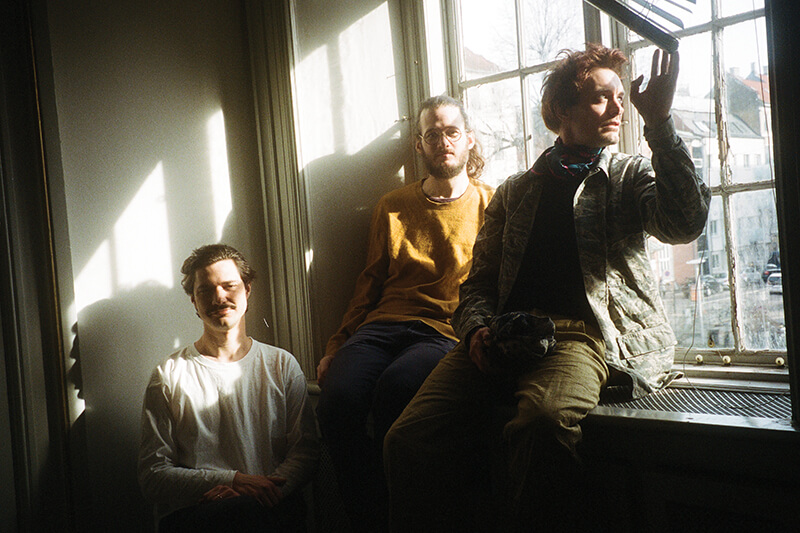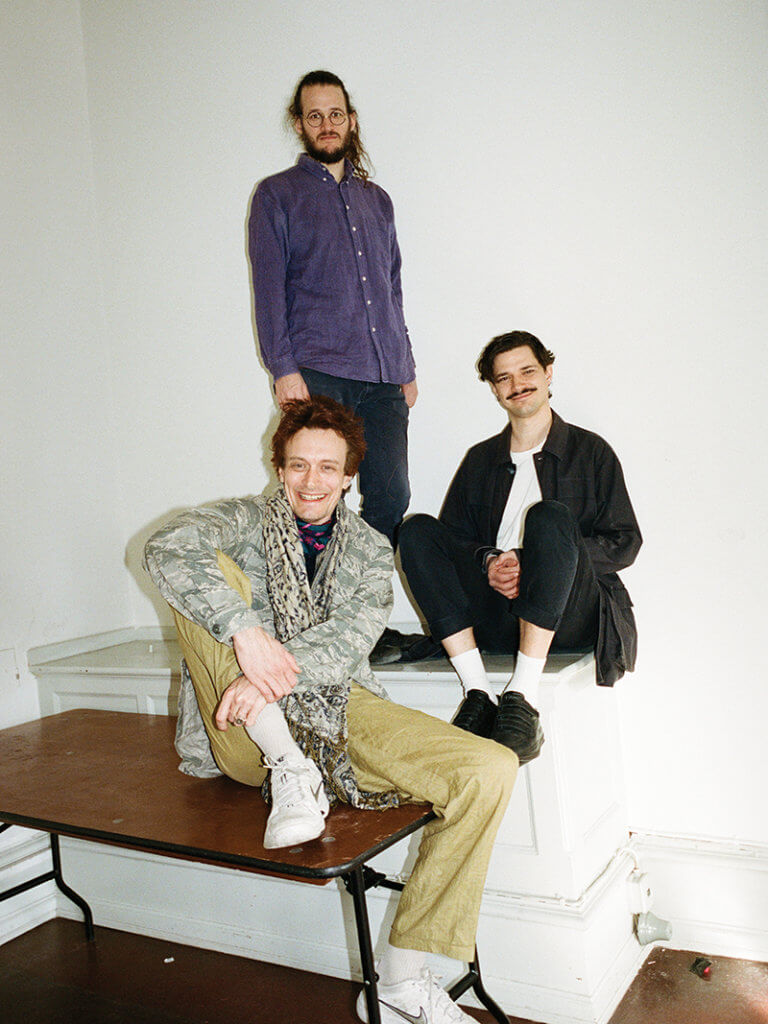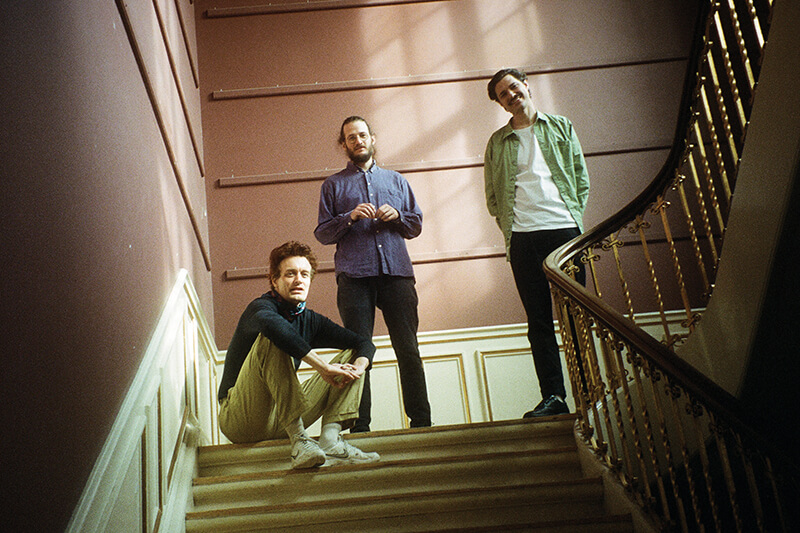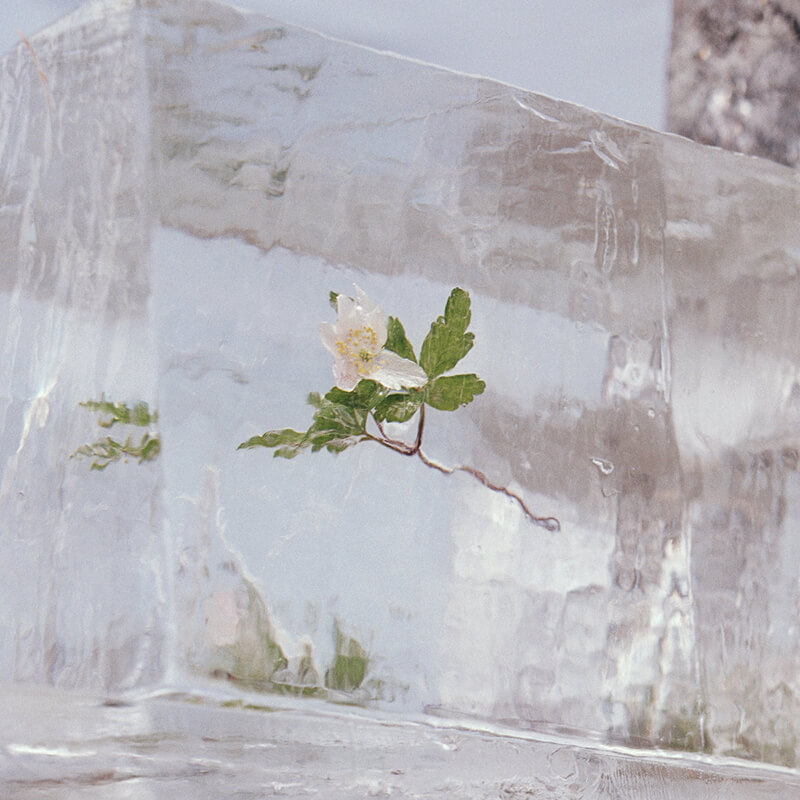Childhood school friends Casper Clausen, Mads Brauer and Rasmus Stolberg grew up on the tiny Danish island of Als, sharing their love of electronic and classical music. Now known as Efterklang, the collective has become renowned for its thought-provoking, spatial chamber pop, blending elegant acoustic instrumentation with abstract electronics.
Seeking to challenge themselves with each subsequent release, the pandemic forced the trio to redefine their recording methods. The title of their fifth studio album, Windflowers – a genus of breezy flower blossoms spread across the Danish forest floor, symbolises the sense of hope and change that has swept through the band members’ lives over the past 18 months.
Seeking refuge from the constant reminder of Covid’s invisible threat, the band took refuge at RealFarm – a residential studio on the island of Mon, south of Copenhagen. Armed with up to 80 songs and demo sketches, the trio embarked on a creative journey that brought them closer together even as their lives grew apart, distilling their ideas into what has become their most concise, direct and dare we say, pop-oriented album to date.Falling back on their experience of playing instruments and producing themselves, Efterklang reconnected with the playfulness and joy of making music together as they had done when first forming 17 years ago. We spoke to songwriter Mads Brauer about the band having to accept its limitations.

***********************************
It’s mentioned that the new Efterklang album helped the group grow closer together. How did you achieve that when the pandemic has forced most people apart?
We were working in a residential studio one-and-a-half hours south of Copenhagen where we could be together and isolate for periods of time without any distractions. In cities you’re constantly reminded of all the things you cannot do and people are wearing masks, but in the country you can still go for a walk or take a swim in the ocean, so we weren’t affected in the same way. It’s always nice to record in a studio that’s isolated because you have fewer distractions from so many external directions.
Did the disruption give you an opportunity to try something different with Windflowers?
It definitely affected the way we recorded and it’s clear that we had to look inside of ourselves rather than outside and get back to a more DIY approach. It was nice not to have to hire musicians, do everything as a band and see the strength in that. At first, we had so many songs that we didn’t really know what the album was. Usually, we work on just 10 or 12, but this time we were trying to finish almost 21 songs.
The album appears to have a more pop-oriented sound. Did you discuss its direction prior to recording it?
When everything was shut down, we were in the middle of a tour, so in April and May 2020 I started going into the studio without a goal to escape into music for a few hours and started making sketches, demos and songs. At the same time, Casper was in Lisbon doing the same and when we met again in the summer, we had around 80 musical ideas and began discussing what we were attracted to collectively. Having a pool of so much music was a way for us to start exploring things in different ways, so there are definitely songs on this album that are more pop-oriented than Altid Sammen or Piramida.

How fully formed were those early demos and sketches?
It varied. Casper’s demos tend to be little songs with minimal instrumentation and vocals, but the track Dragonfly, for example, was pretty close to the way it ended up. My songs might be a synthesizer loop or chord progression with some sounds and a little beat that’s quite open to interpretation. I’d often leave an idea and work on something new the next day, so I was never really attached to anything. I also shared a Dropbox account with Casper who would sometimes add a little vocal line on top of my instrumentation.
You retreated to a studio on the Danish island of Mon. How did you discover that and what did you find there?
Initially, we weren’t looking for a studio per se, we just wanted to get out of the city and go to a cottage, but a friend told us about RealFarm Studio and we fell in love with it as soon as we got there. It’s a really nice spot in a very beautiful part of the country – an old farm that’s been turned into a studio/summer house with a homey, coastal vibe. It’s got a nice big control room so you’re not sitting on each other’s necks.
There’s a grand piano and different instruments in the control room, similar to Berlin where we usually record in one big space together. There was a drum room and an organ on the first floor, so we had stations miked up and ready to go. I played some flute parts on the album, as did Casper, and I picked up the guitar for the first time in a long time and just made sounds rather than trying to play it nicely. We started in June in the beautiful summer and came back in the early fall, late fall and the winter, where it gets quite windy.
Indeed, “Lady of The Rocks” stands out for its wintry atmosphere and seems to employ some quite interesting environmental sounds.
It was actually born out of an improvisation that we created in early January when we were joined by our live drummer Oyunn and Christian Balvig on piano. Initially, we wanted to re-track the song Hold Me Close When You Can but ended up creating this new track. I was processing drums through some effects that made swirly ocean sounds, but the rest was all played in one take and we added flute parts at the end before discovering that it fitted very nicely on the album after the original.

As a rule, does the band tend to rehash lots of previous ideas and turn them into something new?
We definitely bring stuff from the past to the present, but it tends not to cut it because it’s attached to a different period. This time, there was so much music that could go in different directions that we’ll definitely use some of it later. After we did the masters, I actually went back into the studio and mixed five other songs that were already close to being finished, so they can potentially be released. I remember a time when you had to do a B-side and physical singles, or iTunes wanted an extra song, and we were always struggling to come up with ideas, but we were actually talking about turning Windflowers into a double album. In the end we decided to just distil the tracks down and focus on the very best ones. Personally, I can’t listen to albums that are too long because I can never find the time.
Do you feel there is a general lack of tolerance from the consumer to listen to the album format?
Personally, I like the album format because it gives you the possibility to paint a broader picture that has a few different vibes, but it’s also great to listen to a good playlist and Efterklang has its own Spotify recommended playlist featuring music we like. It’s a bit all over the place, but right now I’m really into the new John Grant album, Mary Lattimore and Oliver Coates, which is beautiful stuff.
I always found parallels between your music and the British experimental pop band Talk Talk. Have they been influential?
Definitely, we’re all big fans. Laughing Stock and Spirit of Eden are some of the albums I keep going back to when I need a little peace of mind. There’s also something similar about the method they used to make music, using the studio as a creative compositional tool where you set out to explore something but don’t know how it’s going to come back. We often try to paint pictures while knowing the limits of that aesthetic.

Windflowers album artwork
For the track “Abent Sar” you worked with Axel Willner of The Field. Why was he brought on board?
We wanted to create a dramatic change with that song and make something more electronic and upbeat, but it felt like we were trying to do something we weren’t really good at. We discussed adding real drums but thought it was better to give it to a producer and keep an eye on it. We’d been big fans of Axel, so we asked him to have a go and were really enthusiastic after hearing his first attempt, then we ping-ponged it long distance via Skype and added some soundscapes and flute parts at the end.
Did the band mix the album collectively?
That’s my territory, but this was the first time since our first album that I finished the mixing myself. Creating these sculptures meant we had to make a lot of decisions along the way compared to recording live band takes and overdubbing where you’re able to keep everything unmixed. When an album’s premixed and you have a strong vision of where it’s heading, it’s more difficult for someone else to come in and take control. But I love mixing and find it fun because you can put a different hat on.
What can you tell us about Efterklang Developed, which I understand is designed to enable you to collaborate with fans of your music?
On our last tour we had a local fan-based choir come on stage and sing a few songs with us, which sparked the idea of reaching out to local communities and creating something together. We’ve always had a strong wish to interact with our audience, so we’ve asked people to listen to a new song and react by taking pictures as they’re listening, then we’re going to release a music video with the pictures set to that song. Next time, we’re thinking of doing the same with words, sound or video. We’ve always worked with sampling, so the ultimate dream would be to add lots of audio parts from our audience.
**photos by Dennis Morton
